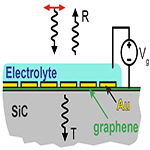Published/Posted: May 1, 2016
Authors: Jadidi, M. M.
DOI: 10.13016/M2NR85
Abstract: The fast-evolving field of condensed matter physics is witnessing a rapid development of a new class of materials, called Dirac materials. The low-energy electronic excitation in these materials behaves like massless Dirac particles. These materials exhibit unique optoelectronic properties, and understanding of Dirac quasi-particle dynamics in two and three dimensions is imperative to realizing the potential applications. In this dissertation, we study two prominent Dirac materials that have unique optoelectronic properties: graphene (two-dimensional) and tantalum arsenide (three-dimensional). While the former can be regarded as the father of materials with a symmetry-protected Dirac spectrum, the latter is a more recent example of topology-protected Dirac materials, also known as 3D Weyl semimetals. We employ spectroscopy and ultrafast optical techniques to study plasmons, and the interaction/relaxation dynamics of photo-excited carriers in these materials. More specifically, we study a new class of plasmon resonances in hybrid metal-graphene structures, which is an important step towards practical graphene plasmonic optoelectronic devices. In addition, we investigate the giant nonlinear THz response of graphene plasmons using pump-probe techniques and discuss the physical origin of the plasmon-enhanced nonlinearity. Furthermore, we introduce a novel continuous-wave photomixing spectroscopy technique to investigate the frequency dependence and nonlinearity of hot-electron cooling in graphene. Finally, we explore the relaxation dynamics of photo-excited Weyl fermions in tantalum arsenide via ultrafast optical pump-probe techniques, which shed light on the electron-phonon relaxation processes in this material.Citation:
M. M. Jadidi, "Plasmonic and Ultrafast Optical Response of 2D and 3D Dirac Materials", PhD Electrical and Computer Engineering, University of Maryland (2016)
Manuscript: Jadidi_PhD_Thesis_2016.pdf
